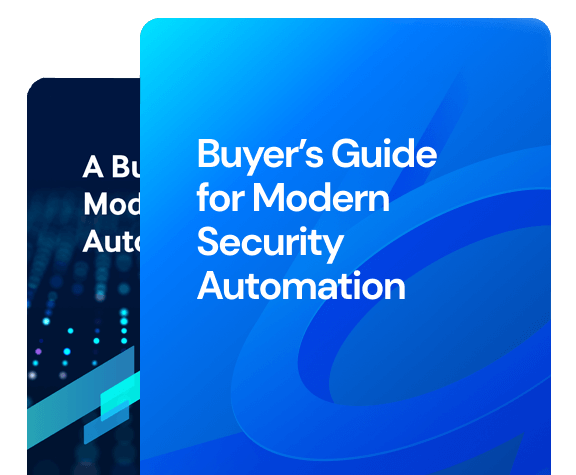What is Data Loss Prevention (DLP)? And How Low-Code Security Automation Can Help
Data is the lifeblood of companies. It drives decision-making, fuels innovation and holds immense value. However, the increase in data also presents significant challenges, particularly in ensuring its security and preventing unauthorized access or loss.
This is where Data Loss Prevention (DLP) and security automation play a crucial role. Let’s explore what DLP is and dive into how security automation can enhance security teams’ effectiveness.
Understanding Data Loss Prevention (DLP)
Data Loss Prevention (DLP) refers to a set of processes, tools and policies designed to identify, monitor and protect sensitive data from unauthorized access, misuse or loss. DLP aims to prevent data breaches, ensure regulatory compliance and safeguard the reputation and integrity of organizations.
Sensitive data can take various forms, such as personally identifiable information (PII), financial records, intellectual property, trade secrets and more. By implementing DLP, organizations can mitigate the risks associated with data breaches, accidental leaks, or insider threats.
The Role of Security Automation in DLP
Manual monitoring and enforcement of DLP policies can be a daunting and time-consuming task. Security automation can significantly streamline DLP processes. Let’s explore how security automation contributes to the effectiveness of DLP:
Insider Threat Investigation and Response: Whether malicious or negligent, insider threats are a major cause of sensitive data loss and exposure. Security automation platforms integrate your tech stack to continuously monitor traffic, endpoint activities and data flows, enabling organizations to detect potential threats in real-time. Automated systems can swiftly identify suspicious activities, such as unauthorized attempts to access sensitive data or data exfiltration, triggering immediate response actions to mitigate the risks.
Policy Enforcement and Incident Management: DLP policies define rules and actions to be taken when sensitive data is at risk. Security automation can enforce these policies consistently and effectively across the entire organization, reducing the chances of human error or oversight. When policy violations or incidents occur, automated incident management systems can generate alerts, initiate incident response workflows and enrich investigations for a swift resolution.
Data Classification and Protection: Data classification is a fundamental aspect of DLP. Automated systems can analyze data attributes, metadata and content to accurately classify and label sensitive information. Classification rules can be adjusted easily to that sensitive data remains protected even as new data is generated or shared across different channels.
Proactive Risk Mitigation: Security automation can proactively identify potential risks and vulnerabilities, enabling organizations to take preemptive measures. Automated vulnerability scanning, patch management, and security testing help identify and address weaknesses in the IT infrastructure and applications, reducing the attack surface and enhancing overall security posture.
Streamlined Compliance and Reporting: Regulatory compliance is a critical consideration for organizations handling sensitive data. Security automation simplifies compliance management by automating data discovery, data mapping and access controls. Automated and dynamic reporting provides accurate and up-to-date records of security activities, facilitating compliance with regulations.
DLP Automation – Benefits and Considerations
Implementing security automation in DLP offers several benefits, including:
- Enhanced Efficiency: Automation streamlines labor-intensive tasks, enabling security teams to focus on critical analysis and decision-making, rather than mundane manual processes.
- Improved Accuracy: Automated systems consistently enforce security policies, reducing the likelihood of human errors or oversight. ML algorithms can also detect anomalous behavior patterns that may go unnoticed by human analysts.
- Increased Scalability: Security automation can handle large volumes of data and rapidly respond to threats, ensuring that organizations can keep up with the growing demands and complexity of data protection.
- Quantifiable Value: Security automation can reduce the time to resolve an incident by 70 to 95%. Alongside customizable metric dashboards and reporting capabilities, security automation platforms can easily highlight the value of security efforts.
However, there are some considerations when adopting security automation:
- Coding Requirements: Security automation platforms offer different coding options. On the spectrum of no-code automation to full-code legacy SOAR platforms, aim for a happy medium: low-code security automation. Security teams gain the simplicity of a no-code platform with the power of a full-code option.
- Customization Capabilities: Your security team may be starting from scratch or already have DLP processes in place. Either way, it’s important to have a security automation platform that is customizable enough to meet your organization’s unique security needs. Consider your current demands, as well as any future demands that may arise.
- Human Oversight: While automation can handle repetitive, time-consuming tasks, human expertise remains essential for strategic decision-making and policy refinement. That’s why it’s critical to keep humans in the loop of automation – and why a platform with approach automation is so important.
DLP plays a critical role in safeguarding sensitive data from unauthorized access or loss. By leveraging the power of security automation, organizations can significantly enhance the effectiveness of their DLP strategies. Real-time threat detection, policy enforcement, intelligent data classification, proactive risk mitigation, and streamlined compliance management are among the many benefits that automation brings to the table.
By embracing security automation, organizations can fortify their defenses, protect their valuable data assets and thrive in an increasingly data-driven world.

A Buyer’s Guide for Modern Security Automation
Cut through the complexity and frustration of SOAR and security automation solutions. This guide analyzes the wide range of security automation platforms available today, so you can find the best solution for your team.
The post What is Data Loss Prevention (DLP)? And How Low-Code Security Automation Can Help appeared first on Low-Code Security Automation & SOAR Platform | Swimlane.
*** This is a Security Bloggers Network syndicated blog from Blog Archives - Low-Code Security Automation & SOAR Platform | Swimlane authored by Ashlyn Eperjesi. Read the original post at: https://swimlane.com/blog/what-is-data-loss-prevention/







